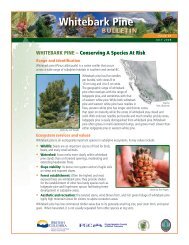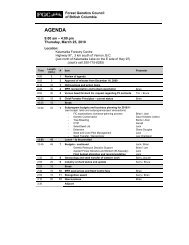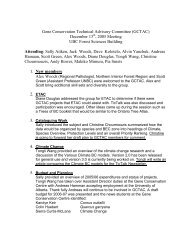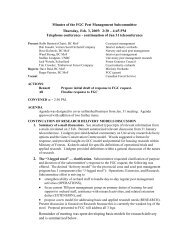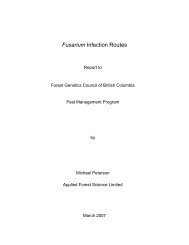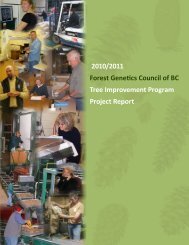Tree Improvement Program Project Report 2006 / 2007
Tree Improvement Program Project Report 2006 / 2007
Tree Improvement Program Project Report 2006 / 2007
You also want an ePaper? Increase the reach of your titles
YUMPU automatically turns print PDFs into web optimized ePapers that Google loves.
Dehydration: Long-shoot bud samples were<br />
preprocessed for the stepwise dehydration series by a<br />
series of four washes in a solution of 0.05 M Sorenson’s<br />
phosphate buffer (pH 7.2) at room temperature. After<br />
either the second or third wash, the buds were descaled<br />
using tweezers and fine scissors.<br />
Plant material was dehydrated by stepwise exposure to<br />
an increased concentration of ethanol in water (30%, 50%,<br />
70%, 95%, 100%). Distilled de-ionized water (ddH2O)<br />
and anhydrous ethanol were used. Each step of the series<br />
was left for a period of 1 h, with the exception of the final<br />
step, which was left for 1.5 h.<br />
Pre-infiltration: Pre-infiltration was carried out<br />
according to the Technovit 7100 instructions. Preinfiltration<br />
solution was made using a 1:1 ratio of Technovit<br />
base to 100% ethanol. Dehydrated buds were immersed<br />
in approximately 5 times their volume and left at room<br />
temperature overnight.<br />
Infiltration: Infiltration solution was made up<br />
according to the Technovit 7100 instructions. One gram<br />
of Hardener I was mixed into 100 mL Technovit base.<br />
Buds were immersed in at least five times their volume of<br />
infiltration solution. The solution was changed twice over<br />
the period of infiltration: once to replace the pre-infiltration<br />
solution and again on the third day of infiltration. After<br />
the last infiltration solution change, the vials were stored in<br />
refrigeration (4°C) until required.<br />
Embedding: Embedding solution was made up<br />
according to the Technovit 7100 instructions. Using a<br />
ratio of 1 mL Hardener II to 15 mL infiltration solution,<br />
the embedding solution was placed in embedding wells (3<br />
cm diameter) using a Pasteur pipette. Bud specimens were<br />
placed in the wells and covered with plastic film to allow<br />
the solution to polymerize. This step took place at room<br />
temperature.<br />
Sectioning and staining: Sections (5 µm) were<br />
obtained using a Leica SM2400 sledge microtome<br />
equipped with a tungsten carbide knife. Each section<br />
was manually flattened in distilled water on clean glass<br />
slides (Technologist Choice), then stained with one of<br />
the following stains: i) Toluidine blue O with sodium<br />
hypochlorite pre-treatment, ii) Safranin O, or iii) Ponceau<br />
2R with Azure II post-treatment (Gutmann et.al. 1996).<br />
Slides were dried at 50°C on a slide warmer, then mounted<br />
in Permount (Fisher Scientific) with clean glass cover slips<br />
(VWR Scientific).<br />
Sectioning strategy and avoidance of bias: To prevent<br />
any bias occurring in the sectioning strategy, information<br />
T R E E I M P R O V E M E N T P R O G R A M<br />
P R O J E C T R E P O R T 2 0 0 6 / 2 0 0 7<br />
concerning the properties of the original clones was<br />
withheld from the investigators until the end. In addition,<br />
the personnel who were trained to do the sectioning used<br />
an initial practice set of a dozen samples, the results of<br />
which are not included. In this way, sample processing<br />
(fixation, dehydration, infiltration, and embedding) was<br />
optimized and staff gained experience on appropriate<br />
material without loss of critical samples. The total number<br />
of samples sectioned was 109 (see Table 24). This represents<br />
the labour of two individuals processing and sectioning<br />
from September to mid-December. More samples were<br />
sectioned from the 18 July to 15 August, <strong>2006</strong> collections<br />
because this period proved to be the most critical.<br />
Results<br />
Female strobili appeared as large axillary buds with an apex<br />
resembling that of a half dome. They were more easily<br />
distinguishable in their later stages of development (Figure<br />
68 and addendum). Bract primordia could be observed<br />
along the proximal margin of the hemispherical apex. Scales<br />
covering the developing strobilus originated at the base of<br />
the bud.<br />
The timing of female strobilus differentiation<br />
varied between the different clones (Table 25). Female<br />
differentiation was easiest to verify in genotypes that were<br />
also high productive cone producers (Table 26). The best<br />
example is 1540, in which only a few samples needed to be<br />
sectioned to find female buds, largely because female buds<br />
were abundantly available. In other samples, particularly<br />
low-producing clones (1524, 1539), it was more difficult<br />
to establish female differentiation, in spite of substantial<br />
sample sectioning effort (Table 24).<br />
Over the course of the summer, long-shoot buds<br />
continued to expand, with the various cones differentiating<br />
along their axes. There were clonal differences in longshoot<br />
bud elongation over the course of the growing season<br />
(Figure 69). The ones with the greatest elongation (1524<br />
and 1539) appeared to have the most delayed female<br />
development. The obverse was found with clones that had<br />
the least elongation (1531 and 1540). One clone — 1506<br />
— had slow elongation initially but increased its rate of<br />
elongation, eventually matching the consistently faster<br />
elongated clones. 1506 had early female development,<br />
which may be linked to the slower initial elongation.<br />
Those clones with the longest long-shoot buds were<br />
from clones that historically had the least number of cones<br />
per tree (Table 26). Assuming the long-shoot bud length is<br />
consistent from year to year and that the cone production<br />
6



